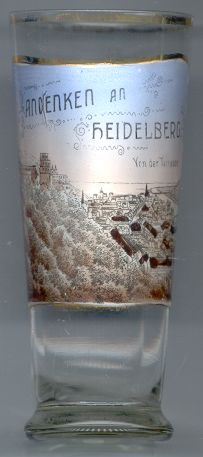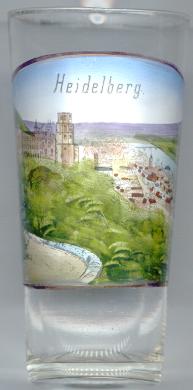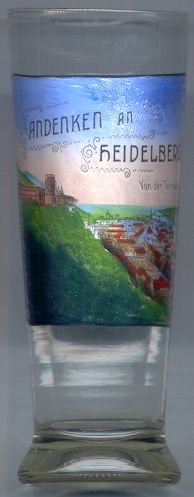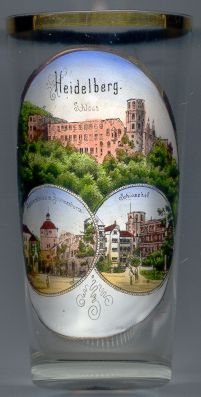

|
| DEUTSCHLAND | GERMANY |
| Bundesland: Baden-Württemberg | |
| Regierungsbezirk: Karlsruhe | |
| Stadt: Heidelberg |
 Heidelberg is stuated at an elevation of 116 m on the river Neckar, where the river leaves the Odenwald mountains and enters the plains of the river Rhine.
Heidelberg itself was first mentioned in 1196, but Handschuhsheim (Hantscuhesheim) and Neuenheim, today part of Heidelberg, had already been mentioned in 765 AD.
For centuries, Heidelberg was the splendid residence of the Electors of the Palatinate (Pfalz). The university, the first in Germany and the third of German-speaking faculty after Prague and Vienna, founded by Elector Ruprecht I in 1386,
became the second most important factor for the historical importance of the town. The industrial development only started after the opening of the railway line from Heidelberg to Mannheim in 1840.
During World War II, Heidelberg luckily suffered only little damage. Today, Heidelberg has a population of about 139,000 inhabitants and is one of the centres of Northern Baden-Württemberg.
Heidelberg is stuated at an elevation of 116 m on the river Neckar, where the river leaves the Odenwald mountains and enters the plains of the river Rhine.
Heidelberg itself was first mentioned in 1196, but Handschuhsheim (Hantscuhesheim) and Neuenheim, today part of Heidelberg, had already been mentioned in 765 AD.
For centuries, Heidelberg was the splendid residence of the Electors of the Palatinate (Pfalz). The university, the first in Germany and the third of German-speaking faculty after Prague and Vienna, founded by Elector Ruprecht I in 1386,
became the second most important factor for the historical importance of the town. The industrial development only started after the opening of the railway line from Heidelberg to Mannheim in 1840.
During World War II, Heidelberg luckily suffered only little damage. Today, Heidelberg has a population of about 139,000 inhabitants and is one of the centres of Northern Baden-Württemberg.

The famous  castle [left] goes back to a medieval castle which came into possession of Duke Ludwig I of Bavaria in 1225 when he became count palatine of the Palatinate in 1225.
From then until the times of the Thirty Years' War, Heidelberg was the residence of the Electors of the Palatinate, one of the most sumptious residences in Germany.
The castle never was a homogenous edifice; instead, every generation added new wings. Elector Ruprecht III (ruled 1398–1410), who became the first German King (Ruprecht I von der Pfalz, 1400–1410),
built the Ruprechtsbau, the oldest representative residential part of the castle. Elector Ludwig V (ruled 1508–1544) enlarged its fortifications;
part of these foritifications is the gate tower (Torturm, 1531–1541) next to the Ruprechtsbau.
Elector Friedrich II (ruled 1544–1556) built the Saalbau, marking the transition from the Gothic to the Renaissance style.
The Ottheinrichsbau was erected by Elector Ottheinrich (Otto Heinrich) (Count Palatine of Pfalz-Neuburg,
Elector of the Palatinate 1556–1559) and was one of the most splendid Renaissance palaces.
The Friedrichsbau was built under Elector Friedrich IV (ruled 1592–1610). The two latter edifices are considered to be two of the most important
buildings in German architectural history. His successor, Elector Friedrich V (ruled 1610–1632) created the famous castle garden (Hortus Palatinus),
the gatehouse Elisabethentor and the English Building, the Englischer Bau. Friedrich V was probably the most unfortunate of the
rulers of the Palatinate. He was elected King by the Protestant nobility of Bohemia in 1619 (Friedrich I of Bohemia), but was ousted by the Imperial troops already in 1620 (hence his sobriquet, 'Winter King').
The imperial troops under general Tilly also conquered and destroyed Heidelberg and its castle in 1622, the title of Elector was given to the Bavarian line of the Wittelbach family.
The famous library, the Bibliotheca palatina, was sent to Pope Gregorius XV as a present by Duke Maximilian I of Bavaria and was incorporated
into the Vatican Library in Rome.
Parts of the castle were rebuilt by Karl Ludwig of the Palatinate, who had regained the title of Elector (ruled 1649–1680),
but the final destruction came with the occupation by French troops during the Palatinate War of Succession in 1693. Elector Carl Theodor, who resided in Schwetzingen, tried to restore the
castle, but lightning struck it in 1764. Since then, the castle fell into dereliction and was used as a quarry. This was stopped during the Romantic period, when the castle became one of the best-known
castles of Germany. The remaining parts were preserved, the last addition was the King's Hall in 1934. Today, the castle is the major tourist attraction of Heidelberg.
castle [left] goes back to a medieval castle which came into possession of Duke Ludwig I of Bavaria in 1225 when he became count palatine of the Palatinate in 1225.
From then until the times of the Thirty Years' War, Heidelberg was the residence of the Electors of the Palatinate, one of the most sumptious residences in Germany.
The castle never was a homogenous edifice; instead, every generation added new wings. Elector Ruprecht III (ruled 1398–1410), who became the first German King (Ruprecht I von der Pfalz, 1400–1410),
built the Ruprechtsbau, the oldest representative residential part of the castle. Elector Ludwig V (ruled 1508–1544) enlarged its fortifications;
part of these foritifications is the gate tower (Torturm, 1531–1541) next to the Ruprechtsbau.
Elector Friedrich II (ruled 1544–1556) built the Saalbau, marking the transition from the Gothic to the Renaissance style.
The Ottheinrichsbau was erected by Elector Ottheinrich (Otto Heinrich) (Count Palatine of Pfalz-Neuburg,
Elector of the Palatinate 1556–1559) and was one of the most splendid Renaissance palaces.
The Friedrichsbau was built under Elector Friedrich IV (ruled 1592–1610). The two latter edifices are considered to be two of the most important
buildings in German architectural history. His successor, Elector Friedrich V (ruled 1610–1632) created the famous castle garden (Hortus Palatinus),
the gatehouse Elisabethentor and the English Building, the Englischer Bau. Friedrich V was probably the most unfortunate of the
rulers of the Palatinate. He was elected King by the Protestant nobility of Bohemia in 1619 (Friedrich I of Bohemia), but was ousted by the Imperial troops already in 1620 (hence his sobriquet, 'Winter King').
The imperial troops under general Tilly also conquered and destroyed Heidelberg and its castle in 1622, the title of Elector was given to the Bavarian line of the Wittelbach family.
The famous library, the Bibliotheca palatina, was sent to Pope Gregorius XV as a present by Duke Maximilian I of Bavaria and was incorporated
into the Vatican Library in Rome.
Parts of the castle were rebuilt by Karl Ludwig of the Palatinate, who had regained the title of Elector (ruled 1649–1680),
but the final destruction came with the occupation by French troops during the Palatinate War of Succession in 1693. Elector Carl Theodor, who resided in Schwetzingen, tried to restore the
castle, but lightning struck it in 1764. Since then, the castle fell into dereliction and was used as a quarry. This was stopped during the Romantic period, when the castle became one of the best-known
castles of Germany. The remaining parts were preserved, the last addition was the King's Hall in 1934. Today, the castle is the major tourist attraction of Heidelberg.


The two small pictures on glass no. 2040 [left] depict
the  Ruprechtsbau
Ruprechtsbau Torturm (here labeled 'Brunnenturm', 'well tower') [bottom left]
Torturm (here labeled 'Brunnenturm', 'well tower') [bottom left]
and the  Schlosshof
Schlosshof
![[scale]](lineal.jpg)